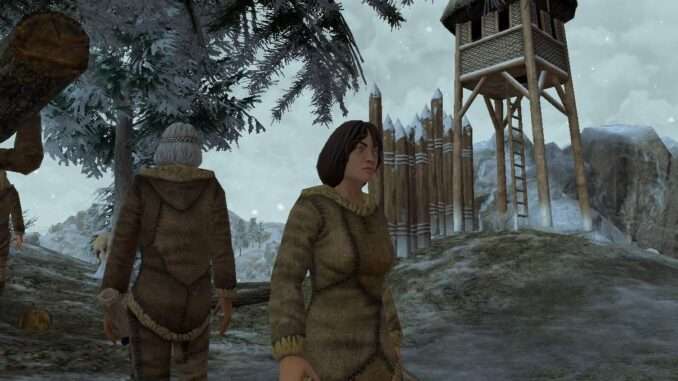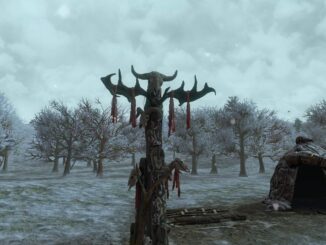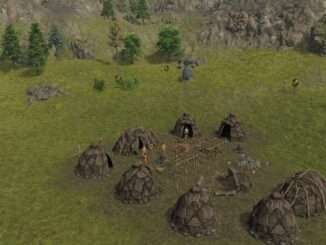
Hunting
Note: Credit goes to Einauga
Animals
Small wild animals are a relatively easy kill for one hunter. Use 3 hunters and a dog for medium-size animals, and 4+ hunters and 2 dogs for megafauna or ancient animals. In later stages of the game, you can cut down on the number of hunters, if hunting would be needed at all. Going for a vegan society in this game is virtually impossible, as it probably was back in the Ages.
Killing animals with multiple hunters is something to master, especially in the early stages when inaccuracy is still rife. Approaching and attacking an animal simultaneously really makes the difference between efficiency and running after deer for miles. Try and align your hunters by moving stragglers or forerunners to certain places and then re-command them to hunt the animal.
Avoid using unhappy, sleepy or hungry people, they easily abandon the hunt when you change commands a few times, besides that they’re slow.
If you don’t have that amount of hunters with tools or dogs for that matter, you can try an kill an animal in intervals. Especially with medium-sized animals which will run after you when attacked, this is a energy-saving method.
If you have only one or two hunters available, go and hunt the targeted (preferably isolated) animal and keep (both) your hunter(s) selected. After 1 or 2 blows, let them sprint off and abandon the attack. The animal (except for wolves and (cave) lions, bears and hyenas) will stop following you or, if a flight-animal, cease running away much sooner. Repeat this until you’ve killed the animal. Another way is to attack from opposite angles simultaneously. Best is to have more angles covered with more hunters, but this will prove effective.
Never attack a single cave animal or megafauna with just one or two hunters. It is certain death.
Cave animals mostly come in flocks of at least 2 adults and with mostly at least 2 cubs. It’s wise to grab a larger group of hunters and go and kill off at least the adult animals that may hang around the village or work areas too closely. These animals generally yield more raw skin than meat, which can be an advantage when you have plenty of food stored already.
Animals will need to drink, so that makes finding hunting targets easier. Wild animals killing other animals by water banks may offer free raw skins and meat, if you are sharp-eyed and act swift but sensibly. Hungry nearby animals may try and beat (or bite) you to it. They will never eat or protect the dead of their own kind though. In time, they will learn that it’s not as safe for them around your parts and will come less close, so your people need to travel out further hunting and collecting.
Hunting Tools
In the early stages, you’ll have wooden spears which offer much less throws and efficiency than their bone or flint counterpart. Avoid crafting wooden spears as soon as you can, unless you wish to trade them. Slingshots are pretty effective too, as they travel just as far as spears, and you can kill a goat with just two shots.
When archery comes into play, you can trust one hunter to kill multiple small animals with two shots, with composite bows just one shot even. One (wo)man with a sword (and shield) can easily kill a wolf and walk away.
Trying to attack animals with fishing spears, harpoons, axes, picks, sickles or just a knife is very ineffective. You’ll have to come close and takes multiple hits to kill – if you haven’t been killed already by then.
Hunting with dogs is often very useful, as they can shield off hunters when the animal directs it anger at the dogs although they can die in the process.
At times they don’t come in as handy and scare off game or hunt them down at great length, spoiling the hunt. When animals are sparse in wintertime, this could be a great set-back.
Dogs are generally easy to find and tamed among wolves, which will start appearing simultaneously with the Dog domestication tech. Beware of protective wolfmothers though.
Domesticating Wolves
When spotted a wolf pack, set out hunters to kill the adults before chasing after the cubs. The adults will attack to protect their offspring, and mostly the wolf whisperer won’t survive alone. Send out at least 2 hunters per adult in the pack, and only after that send out people to catch the orphaned cubs, they will stray around for quite a while.
Hunting Areas
Automated areas set to hunt from, is a feature I as a player hardly use. Any animal that walks through that area is automatically targeted to kill. When the animal walks off, and it may take a while for hunters to finish their tasks and go out to hunt, the animal could have strayed off a great distance. It can take up too much workforce for a relative small yield at far distances. And if the target is a high-risk animal, you might lose people easily that way.
More efficient use would be to plant one or two areas inside the village. Some animals, when scared off, just strolling or targeting your dwellers could end up inside your settlement. You can’t deny an easy kill when it’s handed to you. If a fight-animal starts havoc, at least there will be instant reply.
Domestic Animals
Domesticating animals surely solves the problem of having hunted empty the vicinity, or at any rate, a shortage of game or alternative food.
Only the younger version (cubs, kids or calfs) of animals can be caught and tamed to be a pet dog, goat, sheep, pig, cow, donkey or horse. Both wild and domestic animals procreate yearly once at every turn from winter to spring. The more animals (male/female ratio 1:3) you have, the more yearly offspring they will produce altogether.

Butchery
When looking for wild animals to domesticate, use primal vision mode to roam around and spot your targeted animals. Adult animals yield more material than the young ones, so it’s logical to wait and butcher them until they have grown. Old animals will be butchered automatically when they die, but yield slightly less than their mid-life adult peers. Also animals that cannot find a place in the stables in winter, will die outside of either famine or hypothermia, and be butchered as well.

Expanding
To serve as food and the endless supply of raw skins, having plenty of cattle would be your main goal. To get there, you can start out by building a stable first, and then roam to find as much ibex (goats) as you can to fill that barn. Beware that trying to tame animals far off will exhaust those who will go out to catch them. The auto limit to domestic animals stands at 10, and as you progress and find the surplus too small, build another stable in providence and raise the limit to 15, then 20, etc.
As weaving comes into play, consider replacing the goats with sheep. Kill off all goats in reducing stages to make space for sheep and perhaps cattle already. Above 15 sheep, you’ll have plenty of wool to weave from, so only go higher if you plan to use wool for trade. In the end, finished products such as wool cloth are more valuable than raw materials. Shearing is another task to fulfill, so you may not want to have a huge flock of sheep.
Location
Bundling stables and barley fields, together with haystacks and wells nearby is a good way to efficiently handle and feed your livestock in winter. Make sure you always have reserves on your haystacks, because as your settlement grows bigger along with the amount of grain fields, your people will still be busy getting all of the harvest inside and on stacks at the beginning of winter, and there may not be sufficient people available to feed the animals, so they will perish. Consider having 10 or more stables in the future, and reserve a suitable location for them early on.
Dogs
Dogs can be domesticated and trained pretty early in the game, and come in quite useful while hunting, guarding a kill or the village, but also when attacking raiders. Dogs multiply every year as well as any other animal and are generally easy to find and tamed among wolves, which will start appearing simultaneously with the Dog domestication tech. Beware of protective wolfmothers though. Your people can butcher and eat dog, but their yield is much less than their wild peers.
Dogs are basically fearless and will martyr themselves for the cause. Having a large number of dogs in the settlement, when attacked by raiders, dogs can win you the battle. They always gather by the gate, but will not do anything until you open up, and will go berserk on the invaders from that point.





Be the first to comment